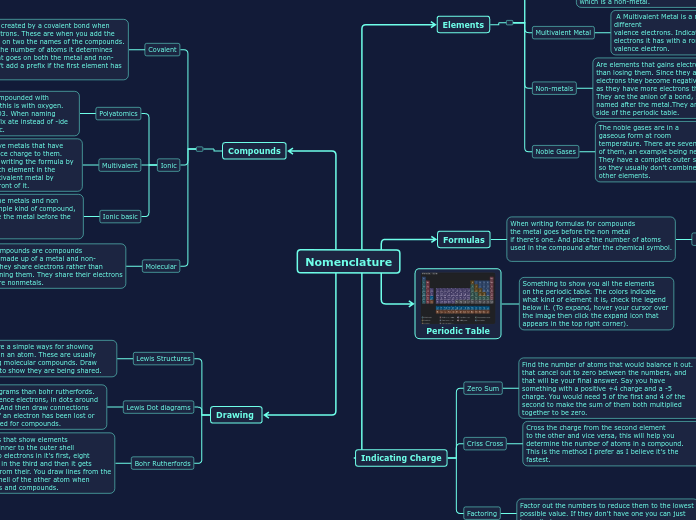Nomenclature
Compounds
Covalent
Is a compound created by a covalent bond when they share electrons. These are when you add the
special endings on two the names of the compounds.
Depending on the number of atoms it determines your prefix, that goes on both the metal and non-metal. You don't add a prefix if the first element has one though.
Prefixes
Ex. Carbon Dioxide CO2
Dihydrogen Oxide. H2O
Fancy name for water.
Ionic
Polyatomics
Polyatomic compounds are compounded with
more than two atoms.Usually this is with oxygen. Such as chlorate, which is CLO3. When naming polyatomics, you add the suffix ate instead of -ide to indicate that it is polyatomic.
Ex.Phosphate= PO4
Multivalent
They are compounds that have metals that have more than one possible valence charge to them. Determine the charge before writing the formula by uncrossing the number of each element in the formula and indicate the multivalent metal by placing a roman numeral in front of it.
Ex. FeO=Iron(II) Oxide
Ionic basic
Basic Ionic compounds are the metals and non metals, which is the most simple kind of compound, and remember that you write the metal before the non-metal.
Ex. Sodium Chloride=NaCL
Molecular
Molecular compounds are compounds
that are not made up of a metal and non-
metal. And they share electrons rather than
losing or gaining them. They share their electrons
since they are nonmetals.
Example: Water
They share electrons
they don't lose or gain
them.
Elements
Diatomics
Diatomic elements are elements that can't exist
on their own. Meaning that they must have two
elements to exist. But it could be another one of itself though. Like Nitrogen, nitrogen is N2 because N1 cannot exist. But they can also bond with other elements to complete themselves, like Carbon Monoxide, as oxygen is a diatomic as well and uses
the carbon to complete itself. And yes, this is a molecular bond, as they are both non-metals.
Metals
Metals are elements that lose their electrons.
And because they lose electrons they are positively
charged as they now have more protons than electrons. They are the cation of a bond, so they are
named before the metal. They are on the left side of
the periodic table. With the exception of hydrogen
which is a non-metal.
Multivalent Metal
A Multivalent Metal is a metal that could have different
valence electrons. Indicate the number of valence
electrons it has with a roman numeral. One for each
valence electron.
Non-metals
Are elements that gains electrons rather
than losing them. Since they absorb
electrons they become negatively charged
as they have more electrons than protons.
They are the anion of a bond, so they are
named after the metal.They are on the right
side of the periodic table.
Noble Gases
The noble gases are in a
gaseous form at room
temperature. There are seven
of them, an example being neon.
They have a complete outer shell,
so they usually don't combine with
other elements.
Formulas
When writing formulas for compounds
the metal goes before the non metal
if there's one. And place the number of atoms
used in the compound after the chemical symbol.
Ex. Octane= C8H18
Periodic Table
Something to show you all the elements
on the periodic table. The colors indicate
what kind of element it is, check the legend
below it. (To expand, hover your cursor over
the image then click the expand icon that
appears in the top right corner).
Indicating Charge
Zero Sum
Find the number of atoms that would balance it out. that cancel out to zero between the numbers, and that will be your final answer. Say you have something with a positive +4 charge and a -5 charge. You would need 5 of the first and 4 of the second to make the sum of them both multiplied together to be zero.
Criss Cross
Cross the charge from the second element
to the other and vice versa, this will help you
determine the number of atoms in a compound.
This is the method I prefer as I believe it's the fastest.
Example: Sodium Phosphide
If it's a multivalent un cross the numbers
to get their charge they specify the multivalent
metal by indicating it's charged by a roman numeral.
Factoring
Factor out the numbers to reduce them to the lowest
possible value. If they don't have one you can just leave it alone.
Example: Octane
Drawing
Lewis Structures
Lewis structures are a simple ways for showing
the valence shells in an atom. These are usually used when drawing molecular compounds. Draw lines to the atoms to show they are being shared.
Example: Carbon Dioxide
Lewis Dot diagrams
These are simpler diagrams than bohr rutherfords.
You only draw the valence electrons, in dots around the chemical symbol. And then draw connections with arrows to show if an electron has been lost or gained when being used for compounds.
Example
Bohr Rutherfords
These are diagrams that show elements
electrons from the inner to the outer shell
An electron has two electrons in it's first, eight
in the second eight in the third and then it gets
more complicated from their. You draw lines from the outer shell to the shell of the other atom when drawing it for bonds and compounds.
Example
